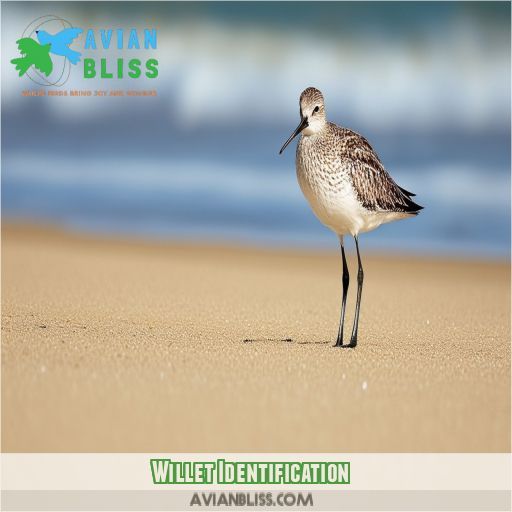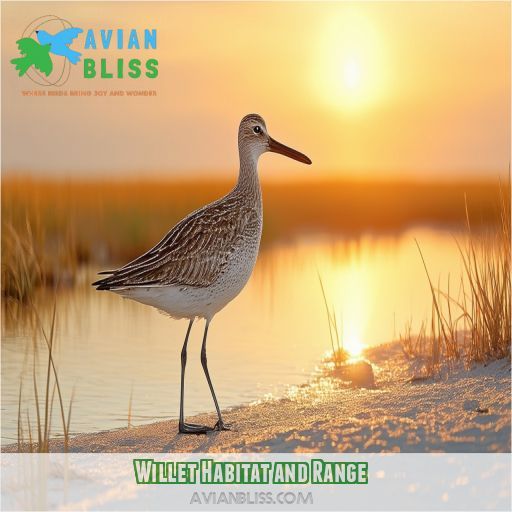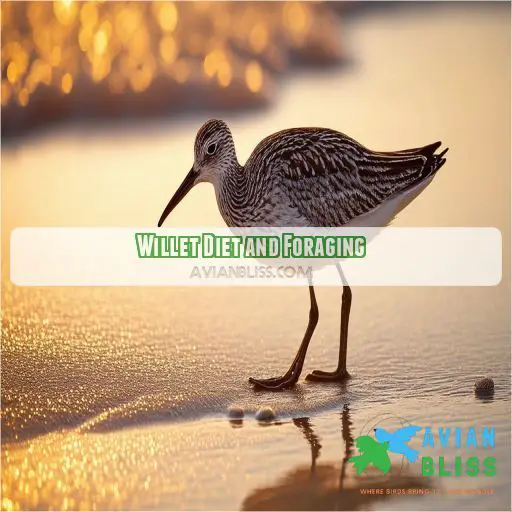This site is supported by our readers. We may earn a commission, at no cost to you, if you purchase through links.

This guide covers all the bases, from identification and behavior to habitat and conservation.
You’ll learn about the willet’s distinctive features, feeding habits, migration patterns, and more.
Table Of Contents
Key Takeaways
- Talk about a feathered multi-tasker! Willets are the Swiss Army knives of shorebirds, adapting to coastal beaches, mudflats, and even inland grasslands. They’re not picky eaters either, switching up their menu from crabs to beetles faster than you can say "surf and turf."
- These birds are the strong, silent type… until they’re not. While they might look unassuming with their gray plumage, once they take flight, it’s like they’ve hit the catwalk. Those bold black and white wing stripes are quite the fashion statement in the avian world.
- Willets are the overachievers of the bird world when it comes to parenting. Both mom and dad pitch in for egg-sitting duties, but dad takes the night shift. Talk about modern family values!
- Who knew these birds were such globetrotters? Willets are seasonal jetsetters, migrating between their breeding grounds and winter vacation spots. They’re like the snowbirds of the bird world, just swap the RV for wings.
Willet Identification
When identifying a willet, look out for its distinctive features, including its large size, chunky shape, subdued plumage, and long thick bill. You can also spot them by their bold black and white wing markings when in flight, their distinctive "pill-will-willet" call, and their habitat, which includes beaches, mudflats, and rocky shores.
Distinctive Features
Willets have a distinctive appearance with their chunky shape, long legs, thick bill, and black, gray, and white colors. Here are three key features to help you identify this shorebird:
- Size: About the size of a crow, Willets are one of the largest common shorebirds.
- Wings: Broad and rounded with bold markings.
- Markings: Subdued plumage, with a mix of patterns.
Wing Markings
Willets have bold black and white stripes on their wings, which are visible during flight and can be used for identification.
Call
Willets have a distinctive call, "pill-will-willet," with quieter "kuk-kuk-kuk-kuk-kuk" sounds. Their calls vary, and humans can’t distinguish them, but the birds can.
Size
The Willet is a large shorebird, about the size of a crow. Its long, thick bill and chunky shape make it stand out among other sandpipers.
Habitat
Willets are versatile birds, adapting to a range of habitats throughout the year. Their habitat includes:
- Coastal areas: Open beaches, marshes, mudflats, and rocky shores.
- Breeding grounds: Grasslands, marshes, and wetlands.
- Winter range: Coastal regions.
- Feeding grounds: Wetlands, mudflats, and beaches.
Subspecies Variations
The Willet has two recognized subspecies: the Eastern Willet and the Western Willet. These subspecies show some distinct differences in their plumage and distribution.
| Subspecies | Plumage Differences | Distribution |
|---|---|---|
| Eastern Willet | Stouter bills, more barring on chest and back | Saltmarshes, barrier islands, and beaches for breeding |
| Western Willet | Larger, paler gray | Near marshes, wetlands, and wet fields for breeding |
Willet Behavior
Willets are active hunters, feeding on a variety of prey both during the day and at night. They’re known to breed and nest in pairs, with males taking on the role of defending their territory and incubating eggs at night.
Feeding
Willets are opportunistic feeders, adapting their diet to available resources and location. Their diet includes:
- Aquatic beetles, fish, and spiders
- Small crabs, worms, clams, and other invertebrates
- Fiddler and mole crabs
Day and Night Feeding
Willets are opportunistic feeders, adjusting their feeding schedule to prey availability. They feed on a variety of prey, from insects to small fish, depending on the time of day and tide patterns.
| Time | Prey |
|---|---|
| Day | Insects, crustaceans, marine worms |
| Night | Small fish, crabs, clams |
| High/Low Tide | Tide pools, sandy beaches |
Breeding
During the breeding season, both male and female willets incubate their eggs. However, only the male willet sits on the nest at night.
Nesting Behavior
Willets often nest in colonies, with the male leading the female to the chosen spot. The nest is a small depression on the ground, often near water. This ground nest is lined with grass and pebbles, measuring about 6 inches across and 2 inches deep.
| Species | Nest Location |
|---|---|
| Western Willets | Inland near ponds and wetlands |
| Eastern Willets | In grasses near saltmarshes or on sand dunes |
Migration Patterns
Willets migrate to warmer climates for the winter, following specific routes and often returning to the same areas annually. Their wintering range spans the coasts of the southeastern United States, Mexico, and Central America.
Willet Conservation
Willet conservation efforts are essential to ensuring the bird’s long-term survival. While the Willet population recovered after the 1918 Migratory Bird Treaty Act banned market hunting, they now face new threats, including habitat loss and degradation.
Historical Decline
Willets were once widely hunted for food, leading to a population decline. Banning market hunting through the Migratory Bird Treaty Act in 1918 helped their recovery. Today, they face threats like habitat loss and coastal development, impacting their future.
- Hunting
- Impact
- Threats
Migratory Bird Treaty Act
The Migratory Bird Treaty Act, enacted in 1918, banned market hunting, aiding the Willet’s recovery from historical hunting pressures. This legal protection is a key step in wildlife conservation, ensuring the Willet’s survival for future generations.
Current Status
Willets are common shorebirds, but populations are declining in certain areas. Despite this, they’re considered a species of "least concern.
Threats
Willet conservation faces challenges from habitat loss due to agricultural development and coastal energy projects, as well as the impacts of climate change. Populations are declining, and the future outlook is uncertain.
Conservation Efforts
Conservation efforts are important to protect Willets from threats like habitat loss. Organizations like the Cornell Lab of Ornithology work tirelessly to make sure their habitats are preserved, ensuring a brighter future for these magnificent birds.
Willet Habitat and Range
Willets are adaptable birds that can be found in a variety of habitats throughout the year. From coastlines to inland areas, their range is quite dynamic, with some interesting seasonal variations to explore.
Year-round Range
Willets are resilient birds, but they face challenges due to habitat loss and degradation. You can find them year-round in these coastal regions:
- Northwest United States
- Southern Canada
- Coastal regions with rocky coasts and mud flats
Breeding Range
Willets breed in the northern Great Plains and the interior of the northwest. Their breeding range includes coastal areas, marshes, and grasslands. During the breeding season, they seek specific nest sites, with Western Willets opting for areas near marshes and wetlands, and Eastern Willets favoring saltmarshes and barrier islands.
| Location | Breeding Range | Nest Sites |
|---|---|---|
| Northern Great Plains | Marshes | Grasslands |
| Interior Northwest | Coastal Areas | Marshes, Wetlands |
| Eastern Coast | Barrier Islands | Saltmarshes |
Migration
Willets migrate to warmer climates in winter, following specific routes and often returning to the same areas each year. They head to the coasts of the southeastern US, Mexico, and Central America.
Wintering Range
During winter, Willets migrate to coastal areas in the southeastern United States, Mexico, and Central America, showcasing their adaptability and range as birds of the world.
Willet Diet and Foraging
Willets are opportunistic eaters, adjusting their diet based on what’s available and where they are. The Western Willet, for instance, enjoys freshwater fish and spiders, while the Eastern Willet prefers crabs, clams, and other small invertebrates from saltwater habitats.
Opportunistic Feeders
Willets are opportunistic feeders, adapting their diet based on available resources and location. Their diet includes a variety of prey, showcasing their adaptability as feeders.
- Insects
- Crustaceans
- Marine Worms
- Aquatic Insects
Western Willet Diet
The Western Willet’s diet varies with the seasons and their location. During the winter, they feed on small crabs, worms, and clams from saltwater sources. In freshwater habitats, they eat aquatic beetles, fish, and spiders.
| Western Willet Diet | Food Sources |
|---|---|
| Winter | Small crabs, worms, clams |
| Freshwater | Aquatic beetles, fish, spiders |
Eastern Willet Diet
Eastern Willets prefer a saltwater diet of small crabs, worms, clams, and other invertebrates.
Feeding Methods
Willets are versatile foragers, adapting their diet to available food sources. They feed during the day and night, taking prey from the surface, wading in shallow waters, or probing in mudflats and beaches.
Probing
Willets use their long, sensitive bills to probe for prey in mudflats and on beaches.
Wading
Willets are wading birds, often spotted in shallow waters. They wade to feed on small crabs, worms, and clams.
Surface Feeding
Willets are surface feeders, taking prey from the water or mud. They also wade in shallow waters.
Willet Nesting and Breeding
Willets are pretty picky when it comes to nesting. They carefully select their nest sites, with the male often taking the lead in choosing the perfect spot. Nests are typically built inland, near water sources like pond edges or raised sites, or along the coast in cordgrass and beachgrass. The nest itself is a small, cozy depression in the ground, lined with finer grasses and pebbles, creating a comfortable home for their eggs.
Willets are committed partners, often staying together for several years and returning to the same nesting sites. They fiercely defend their territories, with males making their presence known through loud challenges to neighbors. Both parents play an active role in incubating their eggs and teaching their young how to feed, ensuring the next generation of Willets has the best chance at survival.
Nest Site Selection
Willets are picky about where they build their nests. Here’s what you need to know:
- Location Choice: Willets typically breed in coastal areas, marshes, grasslands, and near wetlands.
- Habitat Needs: Western Willets prefer nesting near ponds and wetlands, while Eastern Willets seek out saltmarshes and barrier islands.
- Breeding Grounds: Both subspecies of Willets return to the same breeding grounds each year, often nesting in colonies.
- Nesting Success: Picking the right nest site is key to hatching and raising chicks.
Nest Construction
Once a pair of Willets has selected a suitable nesting site, they set about constructing their nest. Western Willets tend to nest inland, choosing spots along pond edges, other seasonal wetlands, or raised sites near water. On the other hand, Eastern Willets favor nesting in cordgrass, saltgrass, and beachgrass habitats near salt marshes, as well as on sand dunes.
Nest Structure
The nest structure of Willets is a small depression, typically just over 6 inches across and 2 inches deep. Here are the key details about their nest structure:
- Nest Materials: Willets use finer grasses and pebbles to line their nests, creating a comfortable and protective layer.
- Nest Location: Western Willets prefer nesting near water, either along pond edges or on raised sites nearby. Eastern Willets choose cordgrass, saltgrass, or beachgrass habitats near salt marshes or sand dunes.
- Nest Lining: The lining adds a soft and insulating layer to the nest, essential for incubating eggs.
- Nest Size and Shape: Willet nests are shallow depressions, ensuring a low profile that helps camouflage the nest and protect it from potential predators.
Pair Bonding
Willets are loyal birds, often staying with the same partner for several years and returning to their original nest sites.
Territorial Defense
Willet males are fiercely territorial, defending their nesting and feeding grounds with aggression. They challenge neighbors by performing a ritualized walk along territorial boundaries.
Parental Care
Willet parents share responsibilities, incubating eggs, building nests, and teaching chicks to feed and grow. Only males sit on nests at night.
Willet Interesting Facts and Trivia
Beyond their distinctive features and behaviors, there are some intriguing facts about Willets that are worth noting. From their names in other languages to their longevity and historical accounts, these birds have a few surprises up their wings.
Spanish Name
The Spanish name for the Willet is "Playero Aliblanco.
French Name
The French name for the Willet is "Chevalier semipalmé." Unfortunately, I don’t have any information on the pronunciation, origin, meaning, or usage of this name.
Oldest Recorded Willet
The oldest recorded Willet was a female bird, banded in Oregon, who lived to be at least 10 years and 3 months old. This record highlights the longevity of these birds and the importance of banding for studying their life spans.
Audubon’s Account
John James Audubon, in his "Birds of America" accounts, noted that Willet eggs and young were edible.
Subspecies Calls
Although humans can’t easily distinguish between the calls of different Willet subspecies, the birds themselves can.
Frequently Asked Questions (FAQs)
What bird is similar to a willet?
The lesser yellowlegs is the closest relative of the willet, although it’s much smaller, with a slender bill and bright yellow legs. The greater yellowlegs is also similar but smaller than the willet, with a slender bill and yellow legs.
What does the name willet mean?
The name Willet has a few meanings. It can refer to a “little strong-willed protector", or "little Will", and is usually given to boys. It may also come from the French name Ouellet, meaning "mattock", a pickaxe-like tool.
What is the diet of the willet?
You’ll find willets to be opportunistic eaters. They’ll probe mudflats and beaches for sand crabs, snatch up small fiddler crabs from rocky shores, and feast on aquatic beetles, fish, and spiders in freshwater areas. They’re adaptable diners!
What are some interesting facts about the willet bird?
You’ll find willets fascinating! These large shorebirds have a distinctive "pill-will-willet" call and striking black-and-white wing patterns in flight. They’re known for their clever nest defense, pretending to be injured to distract predators from their eggs.
Whats on the menu for Willets?
You’ll find willets feasting on a diverse buffet. They’ll probe mudflats for crustaceans, snag insects from grassy areas, and even snack on small fish. Their menu adapts to their habitat, whether it’s coastal or inland.
How do they find their food?
Nature’s buffet awaits these feathered connoisseurs. You’d find Willets probing mudflats with their sensitive bills, wading in shallow waters, and snatching prey from the surface. They’re opportunistic feeders, adapting their menu to available resources and location.
Where do they hang out?
You’ll spot these coastal wanderers on beaches, mudflats, and rocky shores. They’re not picky – marshes and wet meadows work too. During breeding season, they’ll venture inland to grasslands and wetlands. Keep your eyes peeled!
How do I know if its a Willet?
Grab your binoculars, time traveler! You’ll spot a Willet by its large size, long straight bill, and gray legs. In flight, look for bold black and white wing stripes. Listen for its distinctive "pill-will-willet" call.
Do they migrate?
Yes, Willets do migrate. You’ll see them move seasonally between breeding and wintering grounds. They’ll fly to warmer coastal areas in winter, then return to their nesting sites in spring. It’s quite a journey they undertake!
Conclusion
You’ve learned about the willet, discovering its unique traits and behaviors.
From its distinctive wing markings to its complex migration patterns, this coastal bird continues to intrigue researchers and bird enthusiasts alike.
As you explore shorelines and wetlands, keep an eye out for the willet’s graceful form and listen for its piercing call.










